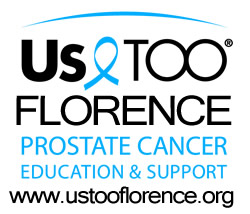|
||||||||
| Home | News You Can Use |
About Us TOO Florence |
Personal Journeys | Slideshows | Contact Us | |||
| Each man's Journey is listed under his BASIC treatment. When you click on one of the names to read a particular Journey, you may see one or more different treatments in bold lettering immediately above the Journey text. You will see (Recurrence) if they are due to a recurrence. Otherwise, they will be treatments used in conjunction with the basic treatment, i.e. Lupron with External Beam Radiation or External Beam Radiation with HDRT/Brachytherapy, etc. | |
Active Surveillance Alternative (Natural) Therapy Cryoablation - Freezing Hormone Therapy Radiation - Brachytherapy Radiation - External Beam Radiation - HDRT Surgery - Open Surgery - Robotic |
Let me start by saying that prostate cancer runs in my family with my grandfather, father and a first cousin all diagnosed with prostate cancer. Because of this I have been vigilant with my health care. In spite of that, my cancer wasn't caught as soon as it should have been. I encourage everyone who reads this to be proactive in their health care. Do not procrastinate, because early detection is the key to recovery. Education about prostate health is readily available right here in Florence. Attend one of the two Us TOO Florence Prostate Cancer Education/Support Chapter meetings held monthly. Call Bob Horney at 541-997-6626 for information. My journey started In California with a colonoscopy in June 2004. The doctor noted a nodule on my prostate and recommended that I see a urologist. On my visit with the urologist in November 2004 my PSA was 2.8. On my next visit in April 2005 my PSA was 3.96 and in May 2005 I had my first biopsy, which was negative. I had three PSA tests in the next 12 months, each higher than the last. In November 2006 I had my second biopsy, which was also negative. From March 2007 to August 2009 I had six PSA tests ranging from a low of 3.9 to a high of 6.0. Since I was exhibiting some of the classic symptoms of Benign Prostatic Hyperplasia (BPH), my General Practitioner (GP) started me on Avodart. In December 2009 my wife and I moved to Florence and I was no longer under a urologist's care. In July 2010 my PSA was 2.5 and my GP here in Florence didn't feel that was high. I had no idea that Avodart would lower my PSA results by half and that 2.5 was actually 5.0. I had read many of the prostate cancer journeys in the Siuslaw News and thought many times that I should attend one of the local Us TOO Florence meetings. If I had, I would have found out that my PSA should be doubled while taking Avodart and would have had the benefit of talking to Dr. Bryan Mehlhaff, a Urologist from Oregon Urology institute (OUI) who attends the meetings. I am certain that my cancer would have been caught sooner and treatment would have begun years sooner had I not procrastinated in attending these meetings. I had the same GP from 2009 to 2013 with the following PSA numbers: July 2011, 2.8, July 2012, 2.7 and July 2013, 3.9. All of these numbers should have been doubled. In July 2014, I was assigned a new primary care physician. My PSA for that visit was 5.1 with a suspicious Digital Rectal Exam (DRE). He was the first to tell me that my 5.1 PSA was actually a 10.2. He referred me to the Oregon Urology Institute and on September 4, 2014 I met with Dr. Walker from OUI. He recommended a biopsy and on September 24, 2014, I had my third biopsy, this one was positive. The cancer was on both sides of my prostate. Nine of the twelve samples were positive, with seven having a Gleason Score of 3+4 and two were 4+3. On October 6, 2014, I had a CT and a bone scan. The tests indicated that the cancer was probably not outside the prostate, but weren't conclusive. On October 14, 2014, I attended my first Us TOO Florence meeting. This was a very positive experience for me and my wife Karen. We heard prostate cancer journeys from men and their wives who had experienced them and the support from the group and Dr. Mehlhaff was outstanding. On October 16, 2014, Karen and I met with Dr. Walker from OUI to discuss my CT and bone scan results. In his opinion my cancer was probably clinical stage T2c, which meant it was in both lobes (sides) of my prostate, but still contained within it. We then discussed my treatment options based on the clinical stage and the seven positive biopsy cores which showed Gleason Scores of 3+4=7 and two cores of a more aggressive 4+3=7. After some discussion we felt that my options were surgery or external beam radiation (IGRT). Dr. Walker recommended a second opinion with Dr. Mehlhaff at OUI in Springfield and with Dr. Forsythe, Radiation Oncologist at the OUI Radiation Center. On October 21, 2014, we attended the Us TOO lunch meeting with Dr. Hoff in attendance. I was able to ask some educated questions based on the information provided to me by Dr. Walker. The comments from Dr. Hoff and other att endees were very helpful in narrowing down the decision that we had to make. On October 22, 2014, we met with Dr. Mehlhaff at OUI. He spent over an hour with us going over my results and discussing my preferred options of surgery or external beam radiation. He agreed with Dr. Walker that my clinical stage was probably T2c, but that it could be T3a since one side of the prostate was so full of cancer. The T3a clinical stage would mean that the cancer had spread beyond the outer layer of the prostate on that one side. Dr. Mehlhaff felt that surgery or radiation would be appropriate for me and concurred with Dr. Walker's referral to Dr. Forsythe. On October 28, 2014 we met with Dr. Forsythe at the OUI Radiation Center. Dr. Forsythe gave me a complete exam and spent over an hour discussing my options, both surgical and radiation. In his opinion there is a high likelihood that my clinical stage is T3a. He feels that even though the cancer may have escaped the prostate, it is probably just outside the wall of the prostate and not in the seminal vesicles or the lymph nodes. The advantage of radiation in this situation is that the treatment area can be expanded to include the area just outside the prostate which could not be done with surgery. It would preclude having surgery and then coming back for radiation, thus possibly doubling the side effects that I would have to deal with. He recommended radiation therapy and a clinical study for a new hormone deprivation treatment that would involve pills instead of an injection. Hormone therapy is used routinely prior to radiation treatment to shrink the prostate and lower testosterone levels. Testosterone feeds prostate cancer, so lower levels would slow the spread of the disease. The pills would allow for more precise dosage of medication and adjustment of the dosage if necessary. It also would preclude returning to the doctor for a hormone injection every 28 days. I have elected to proceed with radiation therapy and, having qualified for participation, I have been randomized into the hormone treatment clinical study. I will take the medication for nine months and will begin nine weeks of radiation treatments after my PSA and testosterone levels have dropped to acceptable levels. The study requires frequent blood tests, EKGs and general physical exams to ensure that my health is not deteriorating and that the drug is doing what is expected. I started taking the medication on December 16, 2014 and at that time my PSA had risen to 13.4 and my testosterone level was over 500. As of December 22, 2014 my PSA was down to 8.5 and testosterone 36. The medication will continue to lower my PSA and testosterone levels before the radiation treatments start. |
| www.ustooflorence.org Copyright © 2010 - 2025 | |

